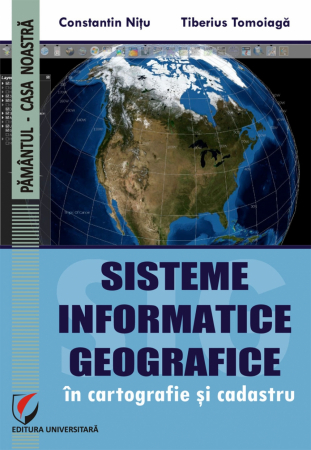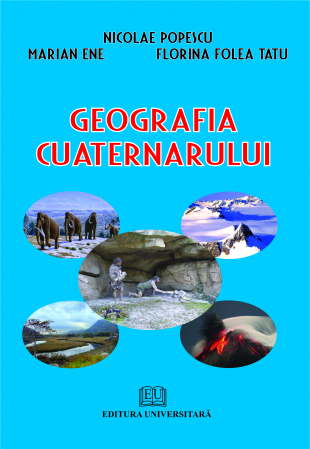ISBN: 978-973-749-479-5
Publisher year: 2008
Edition: II
Pages: 206
Publisher: Editura Universitară
Author: Nicolae Ticleanu, Simon Pauliuc
- Description
- Authors
- Content
- More details
- Reviews (0)
The work "General Geology" aims to contribute to increasing the volume of knowledge of geography students and all those who want to get an overview of: chemical, mineralogical and petrological composition of geological bodies, the relationships between these bodies, ie the structure of the Earth, the forces that determined these relationships and the succession in time of the main geological processes and phenomena, including the evolution of life on Earth.
Born on March 17, 1943. Graduate since 1966 of the Faculty of Geology and Geography, Geology department. Doctor in geology since 1992.
1966-1973, prospecting geologist at the Geological Surveying Company for Solid Minerals.
1973-1995, scientific researcher at the Institute of Geology and Geophysics, specialized in paleobotanical neogene flowers, coal gitology and geological mapping.
Since 1995, associate professor and since 2003 university professor for coal geology and petrology, general geology and geology of Romania; co-author of a treatise on "Geology of coal deposits" and a course on "General Geology".
The scientific activity materialized in over 70 articles published in the country and abroad. Member of the International Committee for Coal Petrography (ICCP). Director of the Research Team for Coal Deposits Geology and Environmental Protection (University of Bucharest).
He has published, alone or in collaboration, over 70 scientific papers in the fields: paleobotany and Neogene paleoclimate, gitology and coal petrography.
SIMON PAULIUC
Born on February 12, 1927. Graduate since 1951 of the Faculty of Geology and Geography of the University of Bucharest. Doctor in geological-mineralogical sciences since 1963.
In 1951 he was employed as a trainer at the Department of Geology of the Faculty of Geology and Geography, then he climbed all the steps of university education, since 1972 he was a university professor.
He is currently a consulting professor and supervisor of doctoral theses in the specialty of Mineral Fuels Geology.
He has published, alone or in collaboration, 12 university courses and synthesis papers including: "General Geology", "Geological Mapping" and "Structural Geology". He also wrote as a sole author or in collaboration over 50 scientific papers, published in the country and abroad, on structural geology, stratigraphy and tectonics of Mesozoic and Neozoic deposits in Romania, coal geology, geological mapping and much more.
1.1. Definitions, objectives, geological disciplines / 8
1.2. Relations of geology with other sciences / 9
1.3. Landmarks in the history of geology / 10
2. Methods and working principles in geology / 13
2.1. Inductive research methods / 13
2.1.1. Direct methods / 13
2.1.2. Laboratory research / 14
2.1.3. Indirect methods / 15
2.2. Deductive research methods / 16
3. Structure and genesis of the earth / 20
3.1. Sources of information / 20
3.2. Internal structure / 21
3.3. Internal structure and global tectonics / 23
3.4. The genesis of the earth / 25
4. Physical properties of the earth / 28
4.1. Gravity / 28
4.2. Pressure / 28
4.3. Caloric energy / 29
4.4. Radioactivity / 31
4.5. Magnetism and paleomagnetism / 32
4.6. Electricity / 34
5. Chemical and mineralogical composition of the earth's crust / 36
5.1. Chemical composition of the bark / 36
5.2. Minerals of the earth's crust / 37
5.2.1. Crystallization: causes, forms and systems / 37
5.2.2. Classification of minerals / 38
5.2.3. Mineral identification criteria / 40
6. Processes and magmatic rocks / 44
6.1. Plutonic processes / 44
6.1.1. What is magma?
6.1.2. How is magma formed?
6.1.3. Magmatic differentiation / 46
61.4. Magma consolidation / 46
6.1.5. Postmagmatic processes / 48
6.2. Volcanic processes and phenomena / 48
6.2.1. Ascension of magmas to the surface / 48
6.2.2. Prediction of volcanic eruptions / 49
6.2.3. Post-volcanic phenomena / 49
6.3. Magmatic rocks / 50
7. Exogenous processes and sedimentary rocks / 54
7.1. Physical-mechanical processes / 54
7.2. Transport of disaggregated material / 56
7.3. Chemical processes / 58
7.4. Biotic processes / 59
7.5. Sediment diagenesis / 60
7.6. Deposition systems / 60
7.7. Components of sedimentary rocks / 62
7.8. Classification of sedimentary rocks / 62
7.8.1. Genetic classification / 62
7.8.2. Chemical-mineralogical composition / 64
7.8.3. The share of the main sedimentary rocks / 64
8. Metamorphism and metamorphic rocks / 66
8.1. Mechanisms of metamorphism / 66
8.2. Metamorphism control factors / 67
8.3. The intensity of metamorphism / 68
8.4. Metamorphic facies / 69
8.5. The structure of metamorphites / 69
8.6. Types of metamorphic rocks / 70
8.7. The circuit of rocks in nature / 71
9. Elements of structural geology / 74
9.1. Notions of geological cartography / 74
9.1.1. The shape of geological bodies / 74
9.1.2. Geological map / 76
9.1.3. Lithostratigraphic columns / 82
9.1.4. Geological sections / 84
9.2. Primary structures / 84
9.2.1. Primary structures of sedimentary rocks / 86
9.2.2. Primary structures of plutonic rocks / 87
9.2.3. Primary structures of volcanic rocks / 89
9.3. Tectonic forces / 89
9.3.1. Causes of tectonic forces / 89
9.3.2. Types of tectonic forces / 89
9.3.3. Types of tectonic movements / 91
9.4. Wrinkled structures / 91
9.4.1. The elements of a fold / 92
9.4.2. Classification of creases / 93
9.5. Rupture dislocations / 95
9.5.1. Cracks / 95
9.5.2. Falii / 98
9.5.3. Incalecari / 102
9.5.4. Tectonic sails / 103
10. Global tectonics / 104
10.1. Ocean bottom expansion theory / 104
10.2. Drifting the continents / 107
10.3. Plate tectonics / 109
10.3.1 Types of boards / 109
10.3.2. Types of boundaries between plates / 110
10.3.3. What kind of forces act in tectonic plates / 111
10.4. Convection currents / 112
11. Seismic movements (earthquakes) / 115
11.1. Elements of seismic movements / 115
11.2. Causes and types of earthquakes / 115
11.3. Magnitude and intensity of skin lesions / 117
12. Major structural elements / 120
12.1. Stable regions (platforms) / 120
12.2. Mobile zones: types of orogeny / 121
13. Elements of paleontology / 124
13.1. Fossils and fossilization processes / 124
13.2. Elements of paleobotany / 128
13.2.1. Procarybionta Empire / 129
13.2.2. Eukaryobionta Empire / 129
13.3. Elements of Paleozoology / 143
13.3.1. Animalia Kingdom / 144
14. Elements of stratigraphy / 129
14.1. Geological time scale / 159
14.2. Stratigraphic ordering / 161
14.3. Stratigraphic dating / 162
14.3.1. Lithostratigraphic method / 162
14.3.2. Biostratigraphic method / 163
14.3.3. Stratigraphic correlation / 164
15. Elements of historical geology / 165
15.1. It was Precambrian / 165
15.2. Paleozoic era / 168
15.2.1. Cambrian Period / 168,
15.2.2. Ordovician period / 170
15.2.3. Silurian Period / 171
15.2.4. Devonian period / 175
15.2.5. Carboniferous Period / 177
15.2.6. Permian Period / 178
15.3. Mesozoic era / 183
15.3.1. Triassic Period / 183
15.3.2. Jurassic Period / 185
15.3.3. Cretaceous Period / 193
15.4. Neozoic Era / 193
15.4.1. Paleogene Period / 195
15.4.2. Neogene Period / 198
15.4.3. Quaternary Period / 203
Bibliography / 203
The same media sources announce to us, unfortunately less and less, discoveries of oil deposits, gas, coal, gold, silver, iron, copper and others, without which the very existence and progress of mankind would be under the sign the question. Also from here we learn about the discovery of fossil remains of incredibly large animals such as dinosaurs, as well as progress in predicting catastrophic phenomena such as earthquakes, volcanic eruptions, landslides and the like. All these categories of information are related to the composition, structure, evolution and dynamics of the Earth, elements whose knowledge is among the major concerns of GEOLOGY.
The simple review of the concerns of geology proves that this is, first of all, a practical science, deeply involved in the progress of human society both by providing mineral raw materials and by explaining the causes and prediction of geological risk phenomena, as well as by elaborating more appropriate measures to reduce their effects, to protect people's lives and their material possessions. At the same time, geology provides answers regarding the evolution of the Earth and life on its surface.
In this context, our course aims to contribute to increasing the volume of knowledge of geography students and all those who want to get an overview of: chemical, mineralogical and petrological composition of geological bodies, the relationships between these bodies, ie to the structure of the Earth, to the forces that determined these relations and to the succession in time of the main geological processes and phenomena, including the evolution of life on Earth.
In order to more easily retain important terms, they were collected in separate characters: bold (minerals, rocks and other terms; eg calcite, chalcedony, granite), italic bold (groups of fossil organisms, eg trilobites, Lepidodendron etc.) and italics for geochronological units and subunits (Cretaceous, Neogene).
At the end of each important chapter or subchapter we have introduced a series of synthetic schemes, terms to remember, exercises and recapitulative questions, all written in italics.

6359.png)
![General Geology [1] General Geology [1]](https://gomagcdn.ro/domains/editurauniversitara.ro/files/product/large/geologie-generala-2878-630722.jpg)













